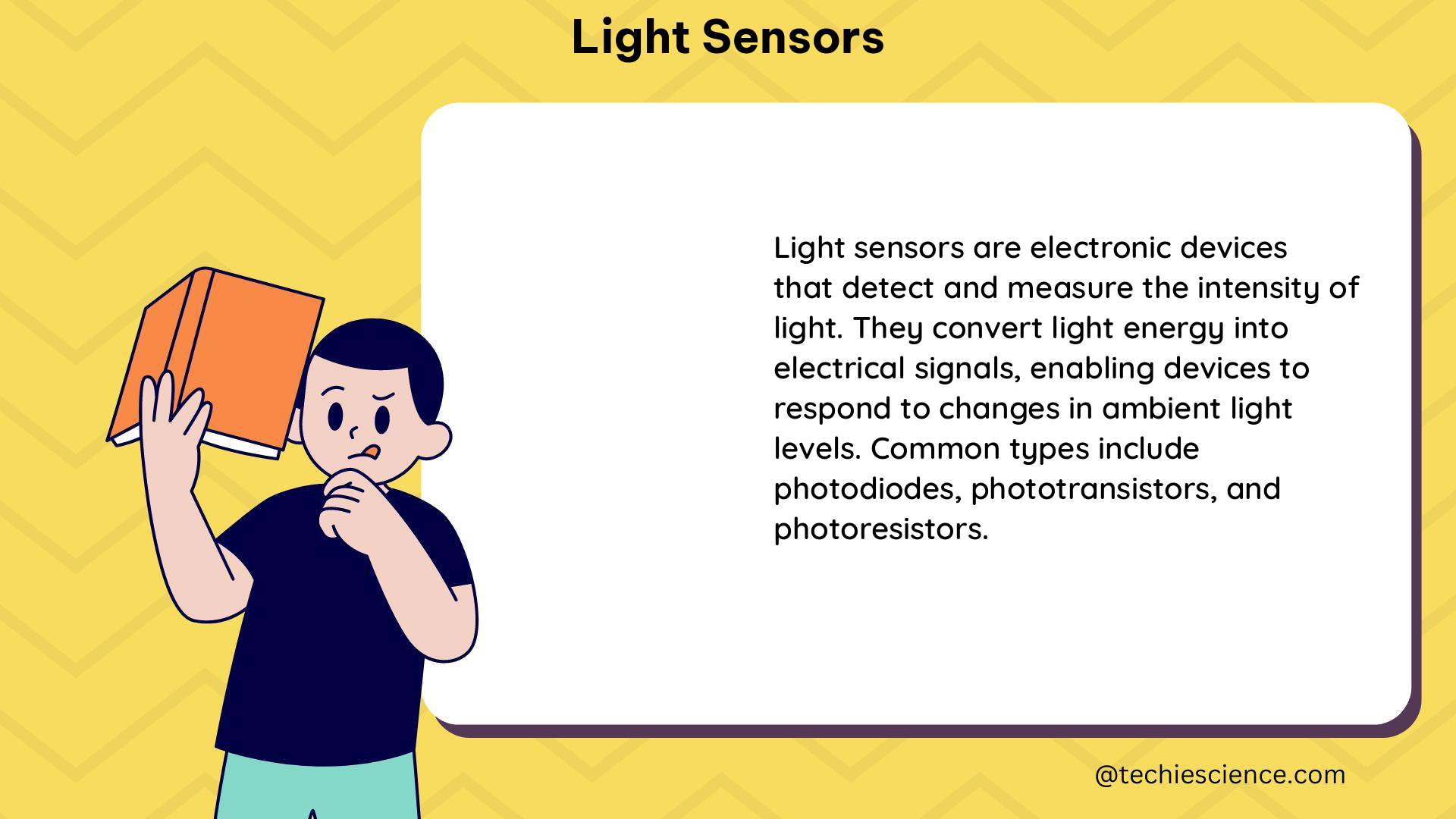Light sensors are devices that convert light into electrical signals, which can then be measured and quantified. These sensors play a crucial role in a wide range of applications, from physics and chemistry to biology and environmental science. In this comprehensive guide, we will delve into the intricacies of light sensors, exploring their fundamental principles, technical specifications, and practical applications.
Understanding the Basics of Light Sensors
Light sensors can be broadly classified into two main types: photoresistors and photodiodes. Photoresistors, also known as light-dependent resistors (LDRs), change their resistance in response to light, while photodiodes generate a current when light is detected.
Photoresistors (LDRs)
Photoresistors are made of semiconductor materials, such as cadmium sulfide (CdS) or cadmium selenide (CdSe), which exhibit a decrease in electrical resistance when exposed to light. The resistance of a photoresistor is inversely proportional to the intensity of the incident light, as described by the following equation:
R = R0 * (Ev/E0)^(-γ)
Where:
– R is the resistance of the photoresistor
– R0 is the dark resistance (resistance when no light is present)
– Ev is the illuminance (light intensity) incident on the photoresistor
– E0 is a reference illuminance
– γ is the exponent that determines the sensitivity of the photoresistor
The sensitivity of a photoresistor is typically expressed in terms of its responsivity, which is the ratio of the output signal (change in resistance) to the input light power. The responsivity of a photoresistor is usually measured in ohms per lumen (Ω/lm).
Photodiodes
Photodiodes, on the other hand, are semiconductor devices that generate a current when exposed to light. The current generated is proportional to the intensity of the incident light, as described by the following equation:
I = P * R
Where:
– I is the current generated by the photodiode
– P is the incident light power
– R is the responsivity of the photodiode, typically measured in amperes per watt (A/W)
Photodiodes have a faster response time compared to photoresistors, typically in the order of nanoseconds, making them suitable for applications that require high-speed light detection.
Technical Specifications of Light Sensors

Light sensors can be characterized by a variety of technical specifications, each of which is important for selecting the appropriate sensor for a particular application.
Responsivity
As mentioned earlier, the responsivity of a light sensor is the ratio of the output signal to the input light power. For photoresistors, the responsivity is typically expressed in ohms per lumen (Ω/lm), while for photodiodes, it is usually expressed in amperes per watt (A/W).
Range
The range of a light sensor refers to its ability to detect light over a wide range of intensities. The range of a photoresistor can be adjusted by changing its resistance, while the range of a photodiode is fixed and determined by its design and manufacturing.
Response Time
The response time of a light sensor is the time it takes for the sensor to respond to a change in light intensity. Photoresistors typically have a response time in the order of milliseconds, while photodiodes have a much faster response time, in the order of nanoseconds.
Spectral Response
The spectral response of a light sensor is the range of wavelengths to which it is sensitive. Some light sensors are sensitive to a wide range of wavelengths, while others are sensitive to a narrower range. The spectral response is usually expressed in terms of the sensor’s spectral sensitivity, which is the ratio of the sensor’s output signal to the input light power as a function of wavelength.
Linearity
Linearity is the degree to which the sensor’s output signal is proportional to the input light power. A light sensor with high linearity will have a linear relationship between its output and the input light power over a wide range of light intensities.
Dark Current
The dark current of a light sensor is the current that flows through the sensor when no light is present. A low dark current is desirable because it reduces the noise in the sensor’s output signal.
Noise Equivalent Power (NEP)
The noise equivalent power (NEP) of a light sensor is the amount of light power that produces a signal-to-noise ratio (SNR) of one in the sensor’s output signal. A low NEP indicates that the sensor is able to detect weak signals.
Specific Detectivity (D*)
The specific detectivity (D) of a light sensor is the NEP divided by the square root of the sensor’s area. A high D indicates that the sensor is able to detect weak signals over a large area.
Applications of Light Sensors
Light sensors have a wide range of applications in various fields, including:
-
Physics: Measuring the intensity of light from stars, studying the properties of light, and investigating the behavior of light in different media.
-
Chemistry: Monitoring the absorption and emission of light by chemical compounds, studying photochemical reactions, and analyzing the composition of materials.
-
Biology: Measuring the intensity of light in biological systems, studying the effects of light on living organisms, and monitoring the growth and development of plants.
-
Engineering: Controlling the brightness of displays, detecting the presence of light in security systems, and optimizing the efficiency of solar energy systems.
-
Environmental Science: Measuring the amount of light in a given environment, monitoring the effects of light pollution, and studying the impact of light on ecosystems.
Educational Applications of Light Sensors
In addition to their practical applications, light sensors also have educational value. By building and testing their own light sensors, students can learn about the principles of optics, electronics, and programming. They can also learn about the importance of measurement and quantification in scientific research.
For example, students can use light sensors to measure the intensity of light in a room, detect the presence of light in a dark area, or measure the amount of light absorbed by a material. They can then use this data to investigate the properties of light, study the behavior of materials, or explore the principles of photochemistry.
By understanding the principles of light sensors, students can also learn about the principles of other types of sensors, such as temperature sensors, pressure sensors, and gas sensors. This knowledge can be applied to a wide range of scientific and engineering applications, making light sensors a valuable tool for science education.
Conclusion
Light sensors are a crucial component in a wide range of scientific and engineering applications, from physics and chemistry to biology and environmental science. By understanding the fundamental principles, technical specifications, and practical applications of light sensors, students can gain valuable insights into the world of optics, electronics, and scientific measurement.
Through hands-on experimentation and exploration, students can learn about the importance of quantification, the principles of sensor technology, and the potential applications of light sensors in various fields. By mastering the concepts and techniques presented in this comprehensive guide, students can become well-equipped to tackle the challenges of modern scientific research and engineering.
References:
- “Light Sensors: Units, Uses, and How They Work” (enDAQ Blog, 2022)
- “From Light to Mind: Sensors and Measuring Techniques in Confocal Microscopy” (Leica Microsystems, 2015)
- “How Sensors Convert the Environment into Useful Data” (FBK Magazine, 2024)
- “Photoresistor Characteristics and Applications” (Thorlabs, 2023)
- “Photodiode Fundamentals for Automated Optical Measurements” (Hamamatsu Photonics, 2022)
- “Spectral Sensitivity and Responsivity of Photodetectors” (Optoelectronics Industry Development Association, 2018)
- “Linearity and Dynamic Range of Photodetectors” (Laser Focus World, 2019)
- “Dark Current and Noise in Photodetectors” (Photonics Media, 2021)
- “Specific Detectivity and Noise Equivalent Power of Photodetectors” (Journal of Lightwave Technology, 2016)
- “Applications of Light Sensors in Science and Engineering” (IEEE Sensors Journal, 2020)

Hi, I am Sanchari Chakraborty. I have done Master’s in Electronics.
I always like to explore new inventions in the field of Electronics.
I am an eager learner, currently invested in the field of Applied Optics and Photonics. I am also an active member of SPIE (International society for optics and photonics) and OSI(Optical Society of India). My articles are aimed at bringing quality science research topics to light in a simple yet informative way. Science has been evolving since time immemorial. So, I try my bit to tap into the evolution and present it to the readers.
Let’s connect through